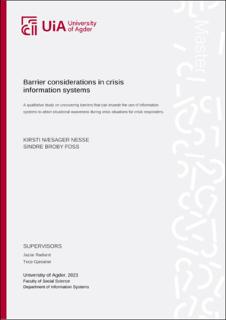| dc.description.abstract | Good decision-making during crisis situations is crucial to ensure fortunate outcomes by minimizing loss and damage. There are many factors that compose good decision-mak-ing, but the level of situational awareness attained is undoubtedly a strong indicator for the quality of decisions. A high level of situational awareness provides the decision maker with a viable basis for making favorable decisions. Thus, to decrease detrimental out-comes of crisis situations, researching how to increase the level of situational awareness is key.
Information systems provide situational awareness by enabling users to obtain and share information. They are used extensively in crisis situations, particularly among crisis re-sponders from police, health, and fire departments. Previous research indicates that there are barriers for using information systems to attain situational awareness in crisis situa-tions. However, there is a lack of previous research that systematically uncovers these barriers and offers a holistic view on barriers and how to mitigate them. The goal of this thesis is to fill the research gap by uncovering barriers that can impede the use of infor-mation systems to attain situational awareness during crisis situations.
In this thesis, a qualitative study was conducted where 14 crisis responders from police, health, and fire services at the tactical and operational level were interviewed. The coding and analysis of the collected data resulted in a total of 43 barriers and themes. All barriers were categorized into one of the following overarching themes: Cognitive, Physical and Technological. Additionally, the data analysis revealed instances of cause-and-effect re-lations between some of the barriers, meaning that the occurrence of one barrier could cause or amplify other barriers. The findings provide useful insight for further research and practice by highlighting aspects of information systems in crisis response that should be considered to improve situational awareness. | |
